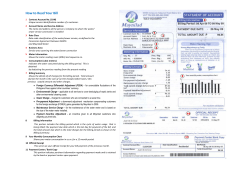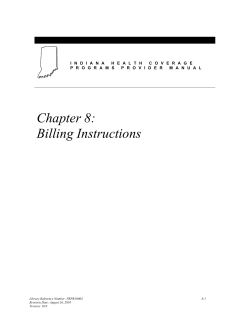
Objectives Ambulatory Care Utilizing CDTM Anticoagulation Management Service
Objectives Ambulatory Care Utilizing CDTM Anticoagulation Management Service • Pharmacy anticoagulation services • Components to setting up a service – – – – – – Valery L. Chu, B.S., Pharm.D., CACP Clinical Pharmacy Specialist – Ambulatory Care Kingsbrook Jewish Medical Center Brooklyn, New York Anticoagulation Management Services • > 1000 anticoagulation clinics in US1 • Staffed by physician extenders: – Clinical pharmacists – Nurse practitioners – Physician assistants • Improve clinical outcomes on anticoagulation therapy – Reduce anticoagulation adverse events – For warfarin, increase time in target INR range Institution support Reimbursement for services Lab Space Documentation Support personnel How to Set Up a Service? • • • • • • Institution support Reimbursement for services Lab Space Documentation Support personnel • Financial incentives – Increase institution revenue – Cost avoidance with lower length of stay Anticoagulation Forum http://www.acforum.com/locations.html Accessed 3/21/08. Administration: Key Players and First Steps • Identify key departments at institution – – – – Pharmacy Medicine (subspecialties) Billing/finance Ambulatory Care • Prepare proposal – Outline benefits of service to institution – Delegate responsibilities Physicians: Why Support and What Role? • Establish value – Specialized anticoagulation management – Pharmacist role and expertise • Identify key physician(s) as service champion • Partner with physician(s) to practice • Identify key physicians as initial referrers • Do not need everyone’s buy-in at start 1 How to Bill for Clinical Services? “Incident to” Billing • WHAT? Service is “... integral, although incidental, part of the physician’s personal professional services in the course of diagnosis or treatment of an injury or illness.” • WHO? Physician bills for services provided by nonphysicians Service requires “… direct physician supervision of auxiliary personnel.” • WHERE? Direct supervision requires “… the physician must be present in the office suite and immediately available to provide assistance and direction …” http://www.cms.hhs.gov/manuals/Downloads/bp102c15.pdf. Accessed March 17, 2008. Key Billing Terms Billing Abbreviation Term Description CPT Current Procedural Terminology Codes to describe health care services ICD-9-CM International Classification of Diseases, Ninth Revision, Clinical Modification E/M Evaluation and Management - American Medical Association Codes and classifies morbidity data - World Health Organization/National Center for Health Statistics Subset of CPT codes (99201 – 99499) that include history, exam, and medical decision • “Incident to” billing • Wording for CPT 99211 – “Office or other outpatient visit for the evaluation and management of an established patient, that may not require the presence of a physician. Usually the presenting problem(s) are minimal. Typically, 5 minutes are spent performing or supervising these services.” • CPT codes for pharmacists to bill not usable • Partner with billing/finance department to finalize method Beebe M, et al. CPT® 2004 Standard Edition American Medical Association; 2004:10 To Describe One Process … • Patients scheduled under attending physician clinic • Pharmacist conducts visit • Case reviewed with physician if complex • Pharmacist completes all documentation • Physician reviews and signs documentation • Visit billed with: – CPT 99211 – ICD-9-CM code for diagnosis requiring warfarin Laboratory Partnership • Anticoagulation laboratory testing – Frequent: International normalized ratio (INR) – Less often: Complete blood count (CBC), basic metabolic panel (BMP), thyroid panel • Why work with laboratory? – Changes in lab workload • Stat INRs • Turnaround time for results – Incorporating INR point-of-care assessment • Patient sees attending physician periodically 2 Point-of-Care (POC) INR Point-of-Care INR Devices • Why POC? – Rapid results – Improve workflow – Enhance provider-patient interaction • Barriers – Laboratory buy-in (regulatory concerns) – Initial acquisition cost – Maintenance costs (cuvettes, equipment) Point-of-Care INR Testing: Which Device to Pick? • CLIA-waived vs non-waived (Clinical Laboratory Improvements Amendment) – CLIA-waived devices Æ low complexity – Non-CLIA-waived devices Æ moderate-high complexity • Wishlist – – – – – – – Barcode ID scanning Electronic interface capable Low sample size Excellent customer support Flexible cuvette storage requirements Easy to use Low maintenance costs Point-of-Care INR Testing: Other Considerations • Billing for INR lab – Replaces traditional laboratory – Determine how test will be billed • Quality control and correlation studies – To demonstrate accuracy and precision of results – To demonstrate reproducibility – Must be completed prior to patient use • College of American Pathologists – Primary group governing laboratory regulations How to Implement POC Testing • Partner with Department of Laboratory – Work with POC coordinator, if present • Research available devices • Contact regional institutions for feedback • Arrange on-site demonstrations • After device selected: – – – – Draft policy and procedure Delineate responsibilities Identify individuals to certify Partner with manufacturer and lab to ensure regulatory compliance Space • Exam room to conduct visits – Dedicated room – Assigned room – Borrowed room • Close proximity to general clinic area • Minimum requirements: – Privacy – Room for wheelchair + caregiver – Sink 3 Documentation Ancillary Support Personnel Written progress note • Obtain permission to document consecutively in progress notes • Create customized note and have Medical Records review Electronic progress note • Proprietary software • • • • Obtain permission to document in system Document level = medical resident Create customized note template Software specific to anticoag documentation and tracking Interface with existing systems Summary of Principle Supporting Depts • To streamline operation, delegate tasks • Tasks to assign – – – – Triage INR POC testing Appointment management No-show follow-up • Who? – Ambulatory care clerical staff – Nursing – Pharmacy technicians Summary of Supporting Depts LABORATORY Pharmacy WHY SUPPORT? • Advance clinical services • Enhance pharmacy relations with other depts ROLE • Direct admin support • Liaison for other depts • Control of personnel Medicine WHY SUPPORT? • Improve patient outcomes • Lessen workload • Access to expertise ROLE • Service champion • Physician collaborator • Refer patients Finance WHY SUPPORT? New reimbursable service • Clinic impact on lab workload • Stat labs and results turnaround • Collaboration for POC • POC testing equipment budget • Resource for lab legislative changes AMBULATORY CARE • Approve appt schedule • Provide clinic space • Equipment budget Supporting Depts CLERICAL ROLE • Billing method • Track reimbursements • Feedback on billing method • Resource for billing legislative changes Delegate nonclinical functions (schedule, make appt reminders, answer telephone, etc) NURSING • Delegate support tasks (vital signs, triage, etc) • Bring patients to exam room • Identify referrals INFORMATION TECHNOLOGY For electronical medical record, assist to streamline documenting 4
© Copyright 2025



















